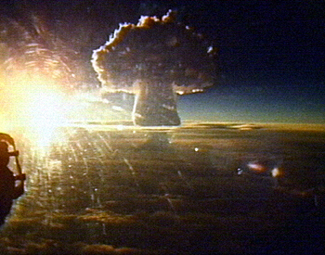Radioactivity is the Absence of Order and Consciousness
If we consider consciousness as fundamental for our reality, space-time, energy and matter, then the logical consequence of this insight is that radioactivity is a kind of absence of the order deriving from consciousness. Claiming that most people would expect at least a billion-dollar-experiment in order to prove this hypothesis. But isn’t it exhilarant to know that most scientific conclusions are made by simple logical thoughts. If radioactivity is absence of consciousness, then the absence of order, or the lack of stability in our reality (caused by radioactivity), would at least lower the consciousness of the life-form who is exposed to it.
In contrary, if consciousness or the act of observation is applied to radioactivity we would at least expect a small but significant change in the chaotic output of radioactive activity. It should become less chaotic. And indeed this is a proven scientific fact.

Global Consciousness Project
The Global Consciousness Project (GCP, also called the EGG Project) is a parapsychology experiment begun in 1998 as an attempt to detect possible interactions of “global consciousness” with physical systems. The project monitors a geographically distributed network of hardware random number generators in a bid to identify anomalous outputs that correlate with widespread emotional responses to sets of world events, or periods of focused attention by large numbers of people. The GCP is privately funded through the Institute of Noetic Sciences2 and describes itself as an international collaboration of about 100 research scientists and engineers.
Roger D. Nelson developed the project as an extrapolation of two decades of experiments from the controversial Princeton Engineering Anomalies Research Lab (PEAR), which Nelson says appeared to show that electronic noise-based, random number generators (RNG or REG, random event generators) seem to be influenced by human consciousness to bring about a less-than-random sequence of data.
In an extension of the laboratory research called FieldREG, investigators examined the outputs of REGs in the field, before, during and after highly focused or coherent group events. The group events studied included psychotherapy sessions, theater presentations, religious rituals, sports competitions such as the Football World Cup, and television broadcasts like the Academy Awards.

The GCP’s methodology is based on the hypothesis that events which elicit widespread emotion or draw the simultaneous attention of large numbers of people may affect the output of hardware random number generators in a statistically significant way. The GCP maintains a network of hardware random number generators which are interfaced to computers at 65 locations around the world. Custom software reads the output of the random number generators and records a trial (sum of 200 bits) once every second. The data are sent to a server in Princeton, creating a database of synchronized parallel sequences of random numbers. The GCP is run as a replication experiment, essentially combining the results of many distinct tests of the hypothesis. The hypothesis is tested by calculating the extent of data fluctuations at the time of events. The procedure is specified by a three-step experimental protocol. In the first step, the event duration and the calculation algorithm are pre-specified and entered into a formal registry. In the second step, the event data are extracted from the database and a Z score, which indicates the degree of deviation from the null hypothesis, is calculated from the pre-specified algorithm. In the third step, the event Z-score is combined with the Z-scores from previous events to yield an overall result for the experiment. The GCP claims that, as of late 2009, the cumulative result of more than 300 registered events significantly supports their hypothesis.
The remote devices have been dubbed Princeton Eggs, a reference to the coinage electrogaiagram, a portmanteau of electroencephalogram and Gaia. Supporters and skeptics have referred to the aim of the GCP as being analogous to detecting “a great disturbance in The Force.”
Coherent consciousness creates order in the world
When human consciousness becomes coherent and synchronized, the behavior of random systems may change. Quantum event based random number generators (RNGs) produce completely unpredictable sequences of zeroes and ones. But when a great event synchronizes the feelings of millions of people, our network of RNGs becomes subtly structured. The probability is less than one in a billion that the effect is due to chance. The evidence suggests an emerging noosphere, or the unifying field of consciousness described by sages in all cultures.
Source: http://teilhard.global-mind.org
Links: